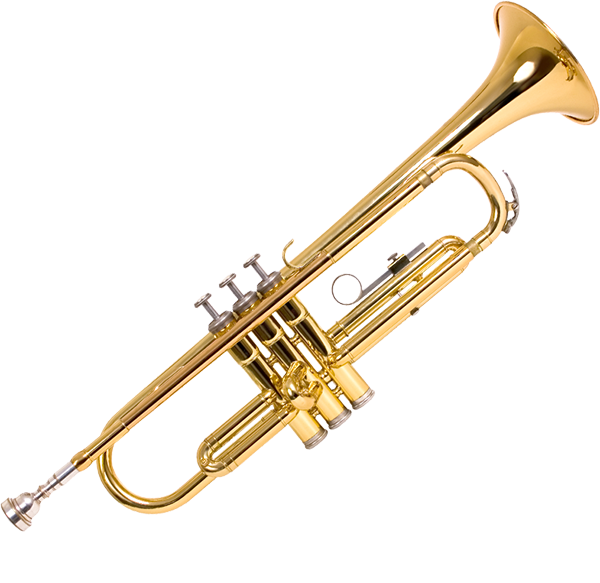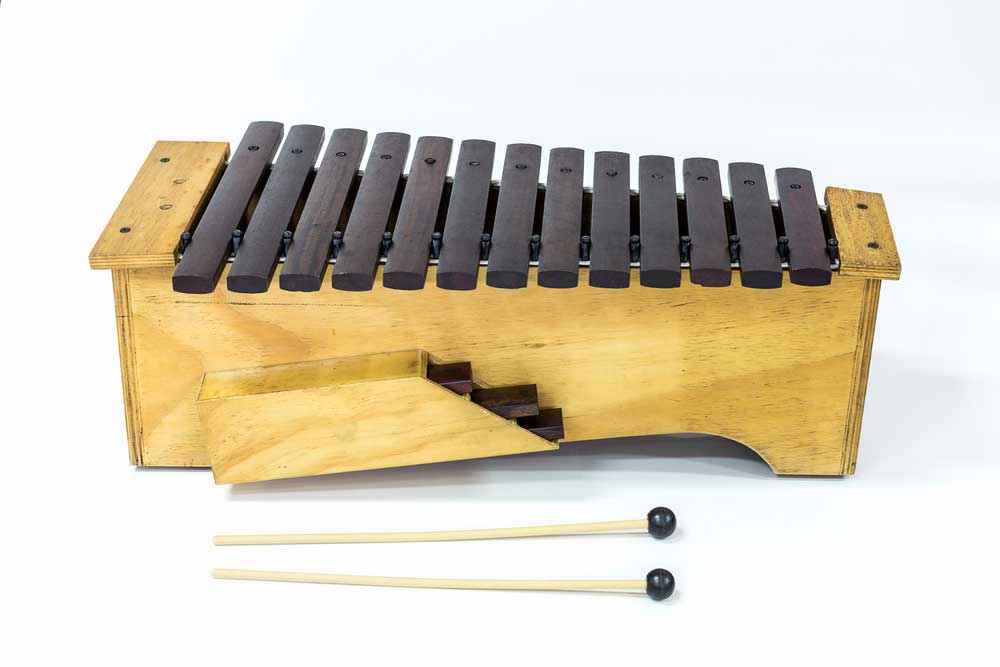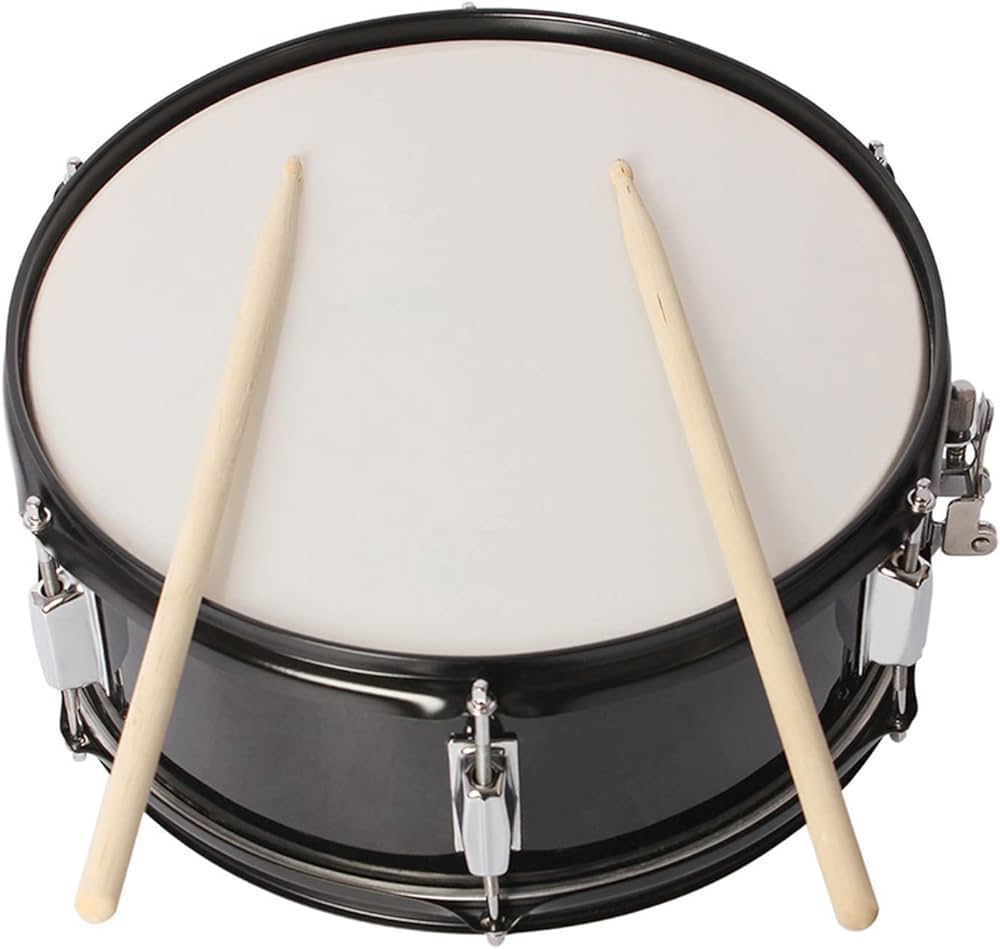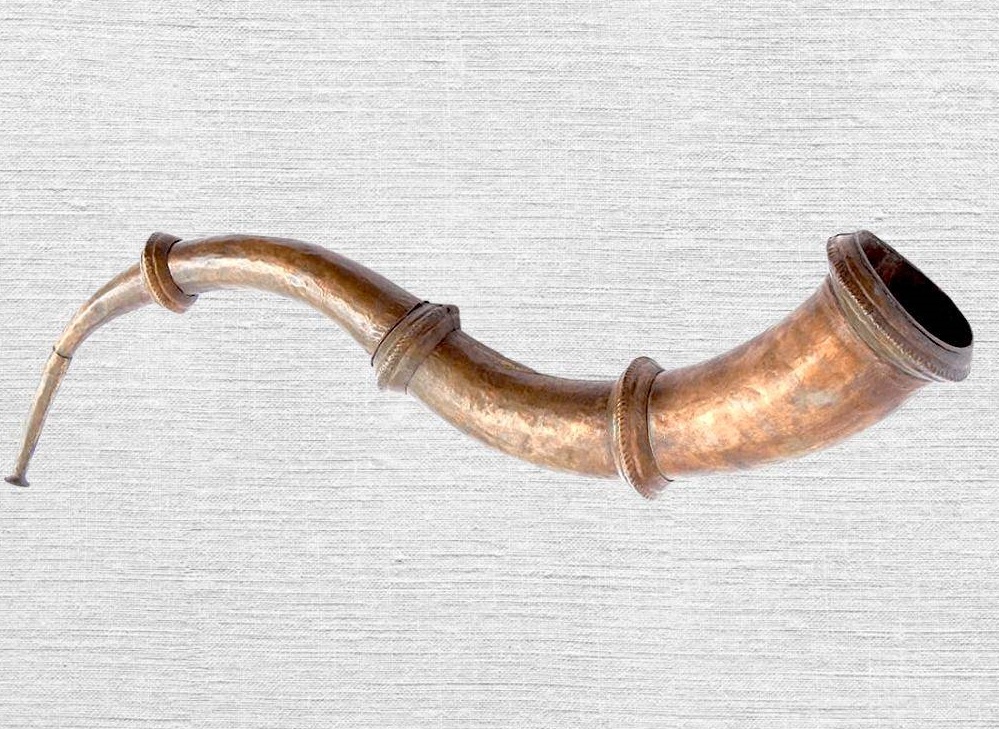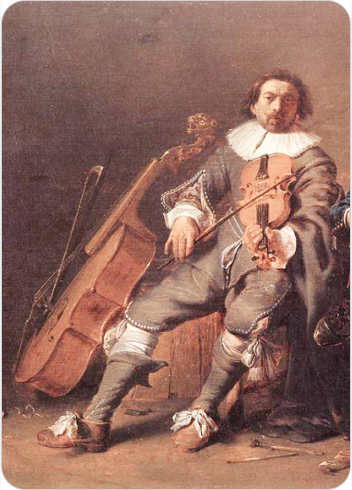Ransingha
Woodwinds
Asia
Ancient
Video
The Ransingha, also known as Narsingha or Ramsinga, is a traditional wind instrument with deep cultural and historical significance in India and Nepal. This primitive trumpet is characterized by its unique S-shape, formed by joining two curved metal pieces. The instrument is primarily made of copper or copper alloys, though earlier versions were crafted from materials such as buffalo horns or even silver in royal courts. Its design allows it to produce a loud, resonant sound, making it ideal for ceremonial and ritualistic purposes.
The Ransingha is an integral part of folk traditions and rituals. It is commonly used in Garhwal folk dramas, religious processions, and celebratory events. Historically, it was played to announce the arrival of kings or to signify victory in battles. The instrument holds mystical significance, as its loud sound is believed to ward off malevolent spirits. Additionally, the Ransingha is often used during weddings and other auspicious ceremonies to add grandeur and festivity to the occasion.
Type of Instrument
The Ransingha belongs to the category of wind or aero folk musical instruments. It is part of a broader group of curved-tube instruments that includes the Sringa and Narsinga, among others. These instruments are known for their ability to produce powerful sounds with minimal tonal variation. The Ransingha is unique in its foldable design, allowing for easy transportation. In terms of musical function, the Ransingha produces only one or two notes, which are sufficient for its primary purpose of signaling or ceremonial use. Its loud and deep sound ensures that it commands attention in any setting. This simplicity in functionality underscores its role as a cultural artifact rather than a complex musical instrument.
History
The origins of the Ransingha can be traced back to ancient times on the Indian subcontinent. It is believed to have been in use since the Vedic period (1500–500 BCE), making it one of the oldest trumpets in South Asia. It is mentioned in ancient Indian scriptures and is often associated with warriors and kings. It was initially crafted from natural materials like buffalo horns, which were later replaced by metals such as copper and bronze. The instrument’s name itself is derived from the Sanskrit word “Srnga,” meaning horn. Over centuries, the Ransingha evolved into its current form while retaining its cultural and ceremonial importance. The Ransingha has been prominently used in regions such as Himachal Pradesh, Uttarakhand, and Nepal. In these areas, it has been an integral part of folk music traditions and rituals. During ancient times, it was played on battlefields to signify triumph or instill fear in enemy ranks. It also served as a royal instrument to announce the arrival of kings or dignitaries. The instrument’s association with victory and celebration has made it a symbol of pride and cultural heritage.
In Nepal, the C-shaped version of the Ransingha is part of the Panche Baja ensemble, a traditional set of musical instruments played during weddings and other ceremonies. Similarly, in Himachal Pradesh, it is used during festivals and to welcome VIPs. The instrument’s historical significance extends beyond music; it has been depicted in literature and art, further cementing its place in cultural history.
Characteristics
The Ransingha stands out due to its distinct features:
Material: Traditionally made from copper or bronze; earlier versions used buffalo horns or silver.
Design: S-shaped with intricate carvings on bronze rings; foldable for portability.
Sound: Produces loud and deep notes suitable for signaling or ceremonial purposes.
Cultural Role: Used in rituals, celebrations, processions, and folk dramas.
Mystical Significance: Believed to ward off evil spirits with its powerful sound.
In addition to its functional attributes, the Ransingha serves as a cultural emblem representing regional heritage and artistic craftsmanship.
Construction and Design
The construction of the Ransingha involves meticulous craftsmanship using copper or bronze sheets. The process begins with cutting a sheet into the required length and shaping it into an S-curve through repeated hammering. The two curved pieces are joined together with metal paste for durability. The joints are heated over charcoal fire to ensure a strong bond. Bronze rings are added along the length of the instrument for structural support and aesthetic appeal. These rings are intricately carved with traditional designs that reflect regional artistic styles. A small circular piece of bronze serves as the mouthpiece, enabling the player to blow air into the instrument effectively. The entire process of making a Ransingha takes about five days and requires skilled artisanship. Once completed, the instrument is polished for smoothness and visual appeal. Its foldable design adds practicality by allowing easy transportation without compromising its structural integrity.
Types of Ransingha
The Ransingha has several variations based on regional practices and cultural preferences:
C-Shaped Narsingha: Commonly used in Nepal by Damai caste musicians as part of Panche Baja ensembles.
S-Shaped Ransingha: Predominantly found in Himachal Pradesh and Uttarakhand; this version is widely used in folk dramas and ceremonies.
Ramsinga: A four-pipe version made from thin metal sheets; associated with specific cultural practices in India.
Buffalo Horn Version: An earlier form made from natural buffalo horns before transitioning to metal construction.
Each type retains the core characteristics of producing loud sounds but differs slightly in design and usage based on local traditions.
Playing Techniques and Sound Modifications
The Ransingha, also known as Narsingha, is a wind instrument that requires significant lung power to play. The musician blows into the narrower end of the instrument with great force, producing a loud and resonant sound. The shape of the Ransingha, typically an ‘S’ curve formed by two joined metal pieces, aids in amplifying its distinct tone. Traditionally, the instrument produces only one or two notes, which are used rhythmically rather than melodically. Skilled players can manipulate their breath control and embouchure (lip positioning) to subtly modify the pitch and tonal quality.
Sound modifications are limited due to the simplicity of the instrument’s design. However, variations in playing technique can create different dynamics and intensities in the sound. For instance, a harder blow produces a louder and more piercing tone, while a softer blow results in a gentler sound. These techniques allow the Ransingha to adapt to various ceremonial or dramatic contexts.
Applications in Music
The Ransingha holds a prominent place in traditional folk music and rituals across Northern India and Nepal. Its loud and commanding sound makes it ideal for outdoor settings such as processions, festivals, and religious ceremonies. Historically, it was used on battlefields to signal commands or celebrate victories, symbolizing triumph and power. In folk dramas, particularly in regions like Garhwal, it adds an atmospheric effect that enhances the narrative.
The instrument is also integral to wedding processions, where it announces the arrival of the groom’s party. In Dogri folk music, the Ransingha contributes to the vibrant cultural expressions of the Dogra community. Beyond its musical applications, it is believed to ward off malevolent spirits during religious processions due to its powerful sound.
Most Influential Players
While the Ransingha is largely associated with collective cultural practices rather than individual virtuosity, certain regions have renowned practitioners who preserve and promote its legacy. These players are often deeply rooted in their communities and serve as cultural custodians. They are typically involved in folk troupes or ritual performances where their expertise ensures the authenticity of traditional practices. In modern times, efforts by cultural organizations and folk artists have brought attention to this ancient instrument. Such individuals act as ambassadors of their heritage, performing at cultural festivals and workshops to educate others about the Ransingha’s significance.
Maintenance and Care
Proper maintenance is crucial for preserving the Ransingha’s functionality and aesthetic appeal. Since it is primarily made of brass or copper (and historically silver), regular cleaning is essential to prevent tarnish or corrosion. A soft cloth should be used to wipe down the instrument after each use, removing moisture and dirt that could damage its surface. If foldable parts are present, they should be carefully disassembled for thorough cleaning without causing dents or misalignment. Applying a thin layer of metal polish periodically can help maintain its shine while protecting against oxidation. Additionally, storing the Ransingha in a padded case prevents accidental dents or scratches during transport. For long-term care, inspections by skilled artisans familiar with traditional instruments can identify any structural issues or wear that might affect performance. This ensures that even antique Ransinghas remain playable for future generations.
Cultural Significance
The Ransingha is deeply embedded in the cultural fabric of Northern India and Nepal. Its origins on ancient battlefields imbue it with a sense of historical grandeur and martial pride. The instrument symbolizes victory over adversity, as reflected in its use during celebrations of divine triumphs in mythology. In religious contexts, the Ransingha is more than just a musical instrument; it is considered a sacred object capable of invoking divine blessings or dispelling negative energies. Its inclusion in rituals underscores its role as a bridge between the human and spiritual realms.
The instrument also serves as a marker of regional identity. Variants like Turri or Turhi are celebrated in different linguistic and cultural traditions across India. The intricate designs etched onto some Ransinghas further highlight their artistic value, showcasing local craftsmanship.
In contemporary times, efforts to revive interest in traditional instruments like the Ransingha reflect broader movements to preserve intangible cultural heritage. Workshops, performances at heritage festivals, and academic studies ensure that this ancient trumpet continues to resonate with new audiences while honoring its storied past.
FAQ
What is the construction and material used in the Ransingha?
The Ransingha is a curved, S-shaped horn made of brass or copper. It consists of two detachable curved tubes that join in the middle. The instrument is crafted by metalworkers using traditional methods. It is often decorated with intricate engravings or embellishments.
What are the types and variations of the Ransingha?
There are two main types of Ransingha: single-curved and double-curved (S-shaped). The variations depend on regional styles and cultural preferences. Some versions have additional decorative elements. The sound quality varies slightly based on the curvature and metal used.
What are the musical applications and cultural significance of the Ransingha?
The Ransingha is traditionally used in ceremonial, military, and religious events. It produces a powerful, resonant sound to signal gatherings or celebrations. Historically, it was played in royal courts and during war. Today, it remains significant in Indian folk traditions.
 Links
Links
References
Other Instrument
Categories

